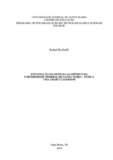| dc.creator | Raffaelli, Rafael | |
| dc.date.accessioned | 2020-03-13T17:55:16Z | |
| dc.date.available | 2020-03-13T17:55:16Z | |
| dc.date.issued | 2019-12-20 | |
| dc.identifier.uri | http://repositorio.ufsm.br/handle/1/19845 | |
| dc.description.abstract | In Latin America most of the class time is consumed by administrative tasks performed by
teachers, including the conference of students attendance. Classrooms are energetically transformed
by technology, through which it is possible to apply knowledge about space and its
members and improve their experience. From this perspective, characterized by smart cities and
campuses, came the smart classroom derivation. Building a smart classroom can help reduce
the time spent doing such a task, as well as improve the environment through sensor monitoring.
Building a smart classroom in isolation limits its benefits, but integrating it with existing
educational software enriches them and can automate processes. Thus, the present work proposes
the integration of a smart classroom to the academic system of the Federal University of
Santa Maria - UFSM, in order to reduce the time spent by the teacher for the conference of
the students attendance. In order to achieve the objectives, searches were made with the literature
of technologies involved in the integration of legacy systems to this new computational
architecture. Secondly, the operating processes, scope delimitation, selection of the hardware
and software necessary for the creation of the smart classroom and the development of the integration
tool called SIoT were defined. . Finally, the implementation of the prototype in the
classroom, which was validated with four undergraduate classes of the Information Systems and
Computer Science courses. It was observed a reduction of up to 92,19% of the time spent for the
conference of students attendance, compared to the methods currently used by the institution.
In addition, the work was successful in creating and integrating with the academic system of
the institution, and may eventually be an integral part of it permanently. The dissertation is inserted
in the research line Educational Software Development, linked to the Graduate Program
in Educational Networked Technologies, and resulted the text presented here, together with the
integration module between smart classroom and the academic system of the institution. | eng |
| dc.language | por | por |
| dc.publisher | Universidade Federal de Santa Maria | por |
| dc.rights | Attribution-NonCommercial-NoDerivatives 4.0 International | * |
| dc.rights.uri | http://creativecommons.org/licenses/by-nc-nd/4.0/ | * |
| dc.subject | Smart classroom | eng |
| dc.subject | IoT | eng |
| dc.subject | Integração | por |
| dc.subject | Fog computing | eng |
| dc.subject | Integration | eng |
| dc.title | Integração do sistema acadêmico da Universidade Federal de Santa Maria - UFSM a uma smart classroom | por |
| dc.title.alternative | Integration of the academic system of the Santa Maria Federal University - UFSM to a smart classroom | eng |
| dc.type | Dissertação | por |
| dc.description.resumo | Na América Latina grande parte do tempo de aula é consumido por tarefas administrativas desempenhadas
pelos professores, dentre elas a conferência dos alunos presentes. As salas de aula
são energicamente transformadas pelas tecnologias, por meio delas, é possível aplicar conhecimento
sobre o espaço e seus integrantes e melhorar a experiência destes. Nessa perspectiva,
caracterizada pelas cidades e campus inteligentes surgiu a derivação smart classroom. A construção
de uma smart classroom pode auxiliar na redução do tempo gasto para tal tarefa, bem
como melhorar o ambiente através do monitoramento por sensores. Construir uma smart classroom
de forma isolada limita os seus benefícios, mas integrá-la aos softwares educacionais
existentes enriquece-os e pode automatizar processos. Assim, o presente trabalho propõe a
integração de uma smart classroom ao sistema acadêmico da Universidade Federal de Santa
Maria - UFSM, com o intuito de reduzir o tempo despendido pelo professor para a conferência
dos alunos presentes. Para que os objetivos fossem alcançados, foram realizadas buscas junto
à literatura de tecnologias envolvidas na integração de sistemas legados a essa nova arquitetura
computacional. Em um segundo momento, foram definidos os processos de funcionamento,
delimitação do escopo, seleção dos hardwares e softwares necessários para a criação da smart
classroom e o desenvolvimento da ferramenta de integração, denominada SIoT. Por fim, a implantação
do protótipo em sala de aula, onde realizou-se a validação com quatro turmas de graduação
dos cursos de Sistemas de Informação e Ciência da Computação. Foi possível observar
uma redução de até 92,19% do tempo desempenhado para a conferência dos alunos presentes,
se comparado aos métodos utilizados atualmente pela instituição. Além disso, o trabalho obteve
êxito na criação e integração com o sistema acadêmico da instituição, podendo futuramente ser
parte integrante do mesmo de forma permanente. A dissertação está inserida na linha de pesquisa
Desenvolvimento de Softwares Educacionais, vinculado ao Programa de Pós-Graduação
em Tecnologias Educacionais em Rede, e resultou o próprio texto aqui apresentado, juntamente
com o módulo de integração entre a smart classroom e o sistema acadêmico da instituição. | por |
| dc.contributor.advisor1 | Medina, Roseclea Duarte | |
| dc.contributor.advisor1Lattes | http://lattes.cnpq.br/6560346309368052 | por |
| dc.contributor.referee1 | Kantorski, Gustavo Zanini | |
| dc.contributor.referee1Lattes | http://lattes.cnpq.br/0721839644753258 | por |
| dc.contributor.referee2 | Voss, Gleizer Bierhalz | |
| dc.contributor.referee2Lattes | http://lattes.cnpq.br/7107448337063502 | por |
| dc.creator.Lattes | http://lattes.cnpq.br/2480505905077752 | por |
| dc.publisher.country | Brasil | por |
| dc.publisher.department | Educação | por |
| dc.publisher.initials | UFSM | por |
| dc.publisher.program | Programa de Pós-Graduação em Tecnologias Educacionais em Rede | por |
| dc.subject.cnpq | CNPQ::CIENCIAS HUMANAS::EDUCACAO | por |
| dc.publisher.unidade | Centro de Educação | por |



